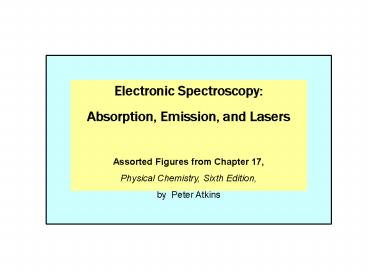Electronic Spectroscopy: - PowerPoint PPT Presentation
1 / 21
Title:
Electronic Spectroscopy:
Description:
... 0-0 transitions are coincident) and resembles a mirror image of the absorption. ... the dissociation limit the electronic spectrum shows a normal ... – PowerPoint PPT presentation
Number of Views:1939
Avg rating:3.0/5.0
Title: Electronic Spectroscopy:
1
Electronic Spectroscopy Absorption, Emission,
and Lasers Assorted Figures from Chapter
17, Physical Chemistry, Sixth Edition, by Peter
Atkins
2
The absorption spectrum of chlorophyll in the
visible region. Note that it absorbs in the red
and blue regions, and that green light is not
absorbed.
blue
red
green
3
According to the Franck-Condon principle, the
most intense vibronic transition is from the
ground vibrational state to the vibrational state
lying vertically above it. Transitions to other
vibrational levels also occur, but with lower
intensity.
4
In the quantum mechanical version of the
Franck-Condon principle, the molecule undergoes a
transition to the upper vibrational state that
most closely resembles the vibrational
wavefunction of the vibrational ground state of
the lower electronic state. The two
wavefunctions shown here have the greatest
overlap integral of all the vibrational states of
the upper electronic state and hence are most
closely similar.
ABSORPTION
5
Transition metal complexes often absorb in the
visible due to the d -gt d transitions. An
example is the electronic absorption spectrum of
Ti(OH2)63 in aqueous solution.
6
A d - d transition in an molecule with inversion
symmetry is parity-forbidden because it
corresponds to a g - g transition. However, a
vibration of the molecule can destroy the
inversion symmetry of the molecule and the g,u
classification no longer applies. The removal of
the centre of symmetry gives rise to a
vibronically allowed transition.
7
A CC double bond acts as a chromophore. One of
its important transitions is the ? ? ?
transition illustrated here, in which an electron
is promoted from a ? orbital to the corresponding
? antibonding orbital.
8
A carbonyl (CO) group acts as a chromophore
primarily on account of the excitation of a
nonbonding O lone-pair electron to an antibonding
CO ? orbital.
Non-bonding Oxygen Lone Pair
9
The sequence of steps leading to fluorescence.
After the initial absorption, the upper
vibrational states undergo radiationless decay by
giving up energy to the surroundings. A
radiative transition then occurs from the
vibrational ground state of the upper electronic
state.
Singlet (S1)
Singlet (S0)
10
An absorption spectrum (a) shows a vibrational
structure characteristic of the upper state. A
fluorescence spectrum (b) shows a structure
charac-teristic of the lower state it is also
displaced to lower energies (but the 0-0
transitions are coincident) and resembles a
mirror image of the absorption.
Energy
0-0 Transition
11
The empirical (observation-based) distinction
between fluorescence and phosphorescence is that
the former stops nearly immediately when the
exciting source is removed, whereas the latter
continues for a longer time period.
12
The sequence of steps leading to
phosphorescence. The important step is the
intersystem crossing, the switch from a singlet
state to a triplet state brought about by
spin-orbit coupling. The triplet state acts as
a slowly radiating reservoir because the return
to the ground state is spin-forbidden.
(S1)
(T1)
(S0)
13
A Jablonski diagram (here, for naphthalene) is a
simplified portrayal of the relative positions of
the electronic energy levels of a molecule.
Vibrational levels of states of a given
electronic state lie above each other, but the
relative horizontal locations of the columns bear
no relation to the nuclear separations in the
states. The ground vibrational states of each
electronic state are correctly located vertically
but the other vibrational states are shown only
schematically. (IC internal conversion ISC
intersystem crossing.)
14
When absorption occurs to unbound states of the
upper electronic state, the molecule dissociates
and the absorption is a continuum. Below the
dissociation limit the electronic spectrum shows
a normal vibrational structure.
15
A schematic illustration of the steps leading to
laser action. (a) The Boltzmann population of
states, with more atoms in the ground state.
(b) When the initial state absorbs, the
populations are inverted (the atoms are pumped to
the excited state). (c) A cascade of radiation
then occurs, as one emitted photon stimulates
another atom to emit, and so on. The radiation is
coherent (phases in step).
16
The transitions involved in one kind of
three-level laser. The pumping pulse populates
the intermediate state I, which in turn populates
the laser state A. The laser transition is the
stimulated emission A ? X.
17
The transitions involved in a four-level laser.
Because the laser transition terminates in an
excited state (A?), the population inversion
betweeen A and A' is much easier to achieve.
18
The transitions involved in a helium-neon laser.
The pumping (of the neon) depends on a
coincidental matching of the helium and neon
energy separations, so excited He atoms can
transfer their excess energy to Ne atoms during a
collision.
19
The transitions involved in an argon-ion laser.
20
NdYAG laser Yttrium aluminum garnet (YAG)
crystal with 1-2 Nd3 impurities. 1.06 mm
1064 nm
21
Io
t
Lifetime t 1/kobs is the time t t that it
takes for I(t) to fall to 1/e its initial value
or I 0.37 Io.































